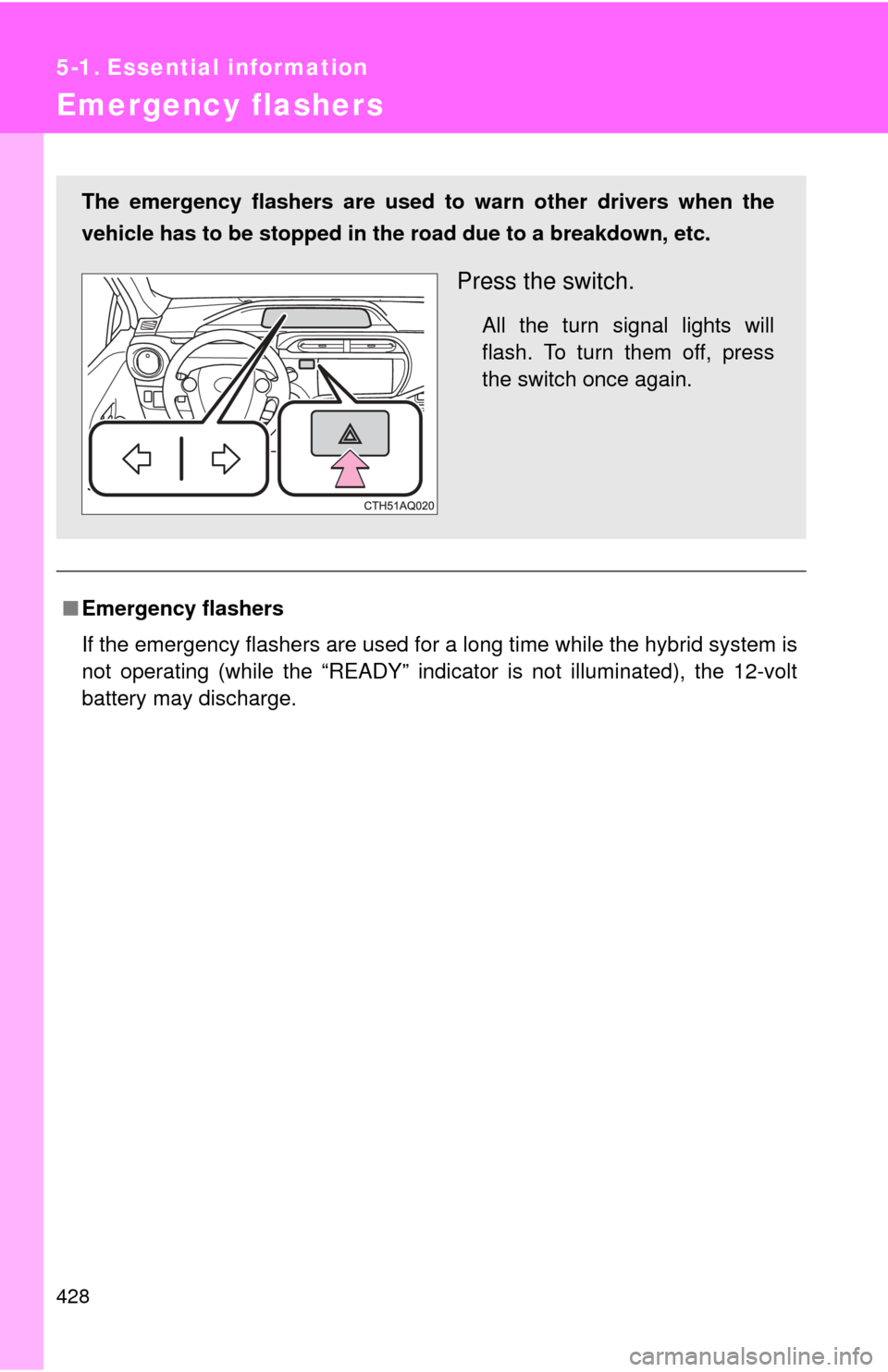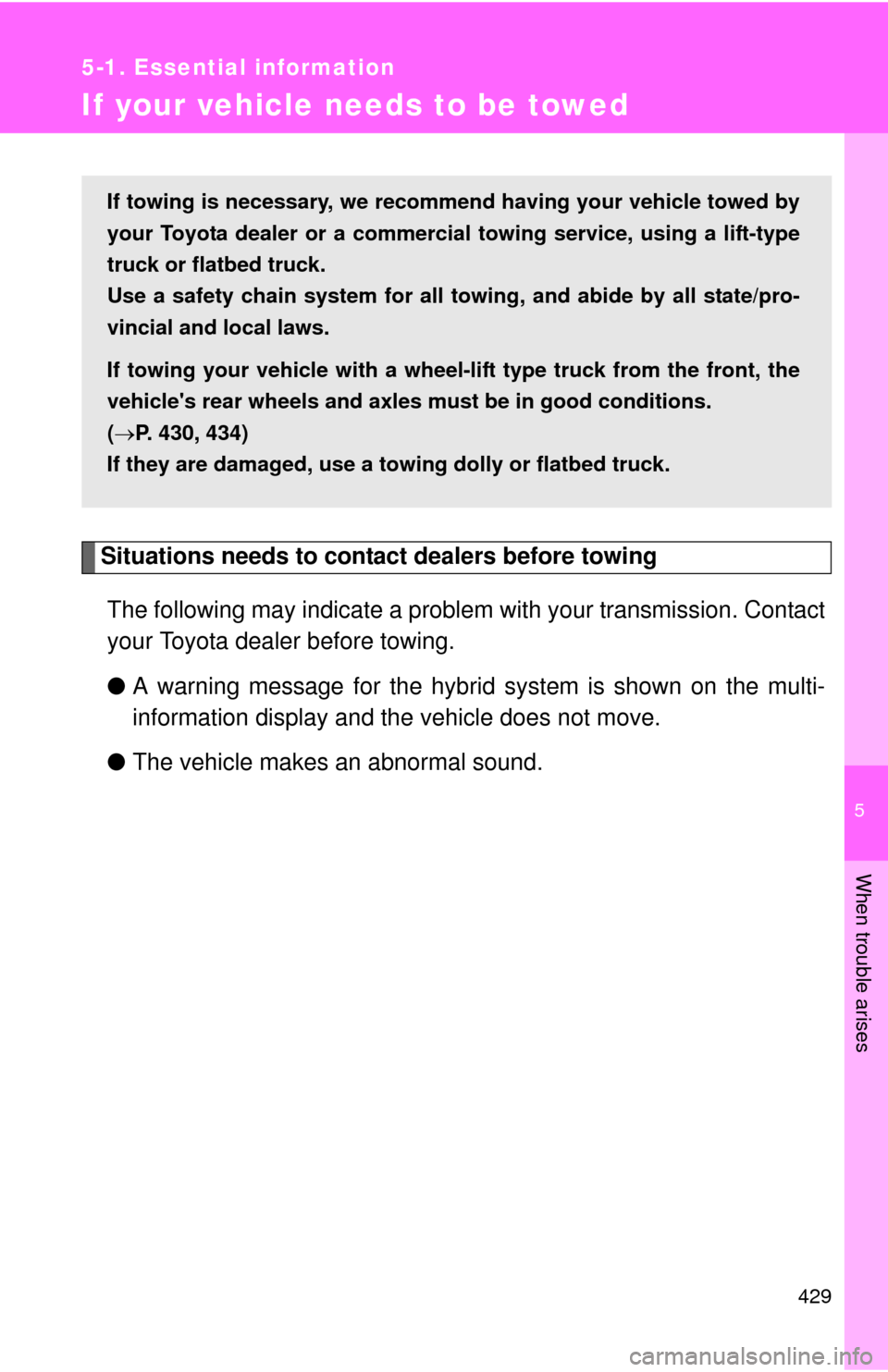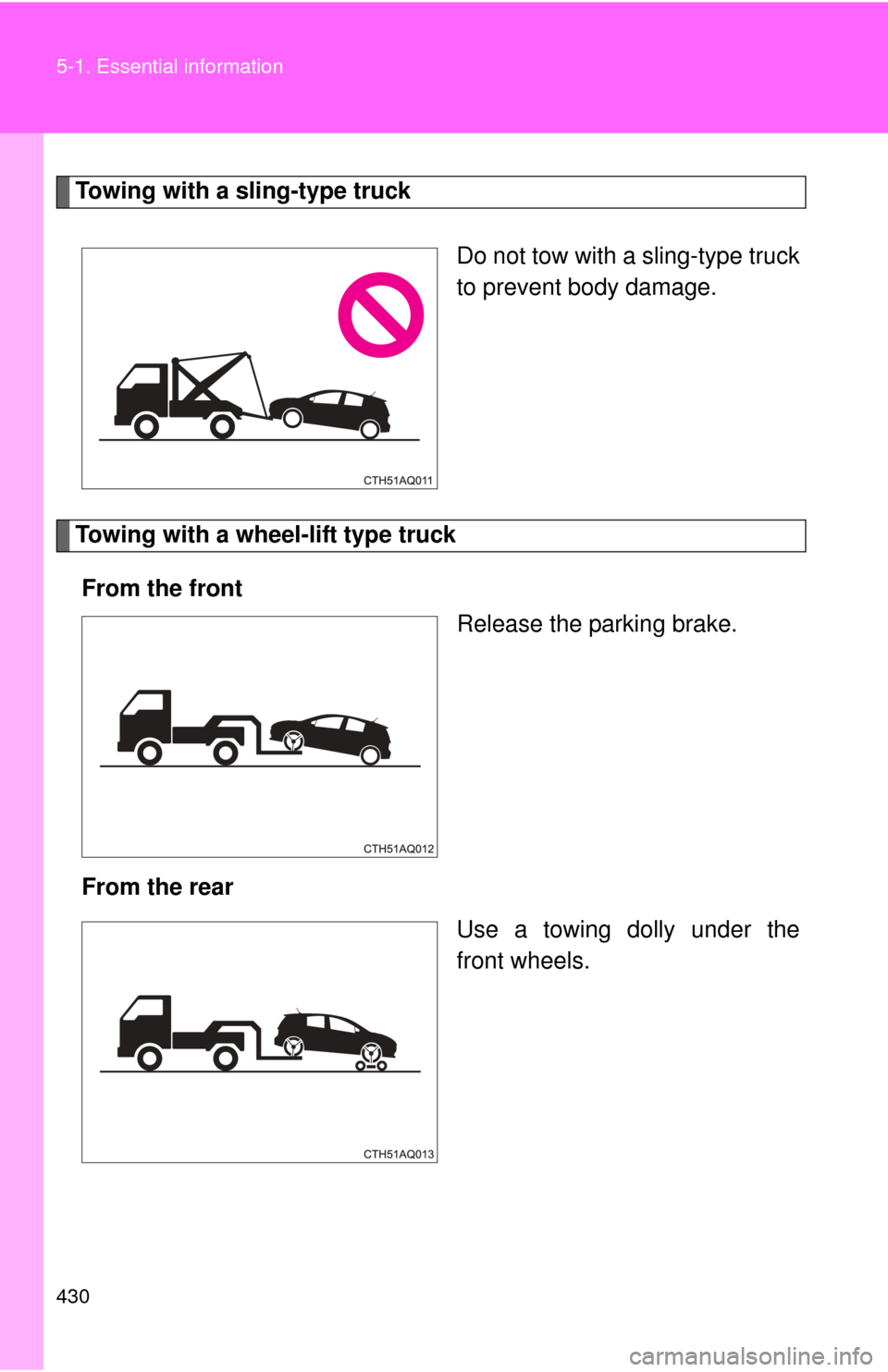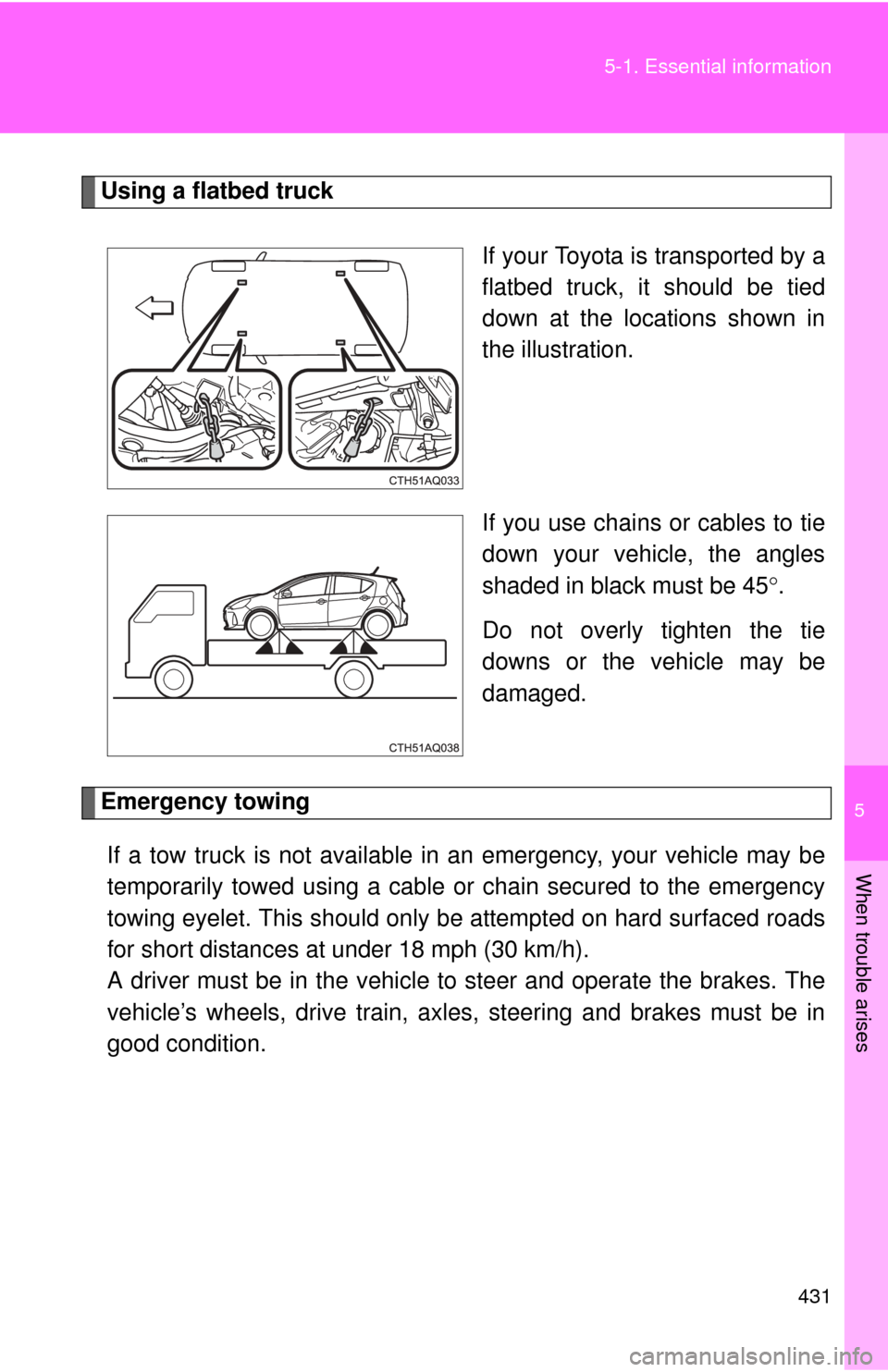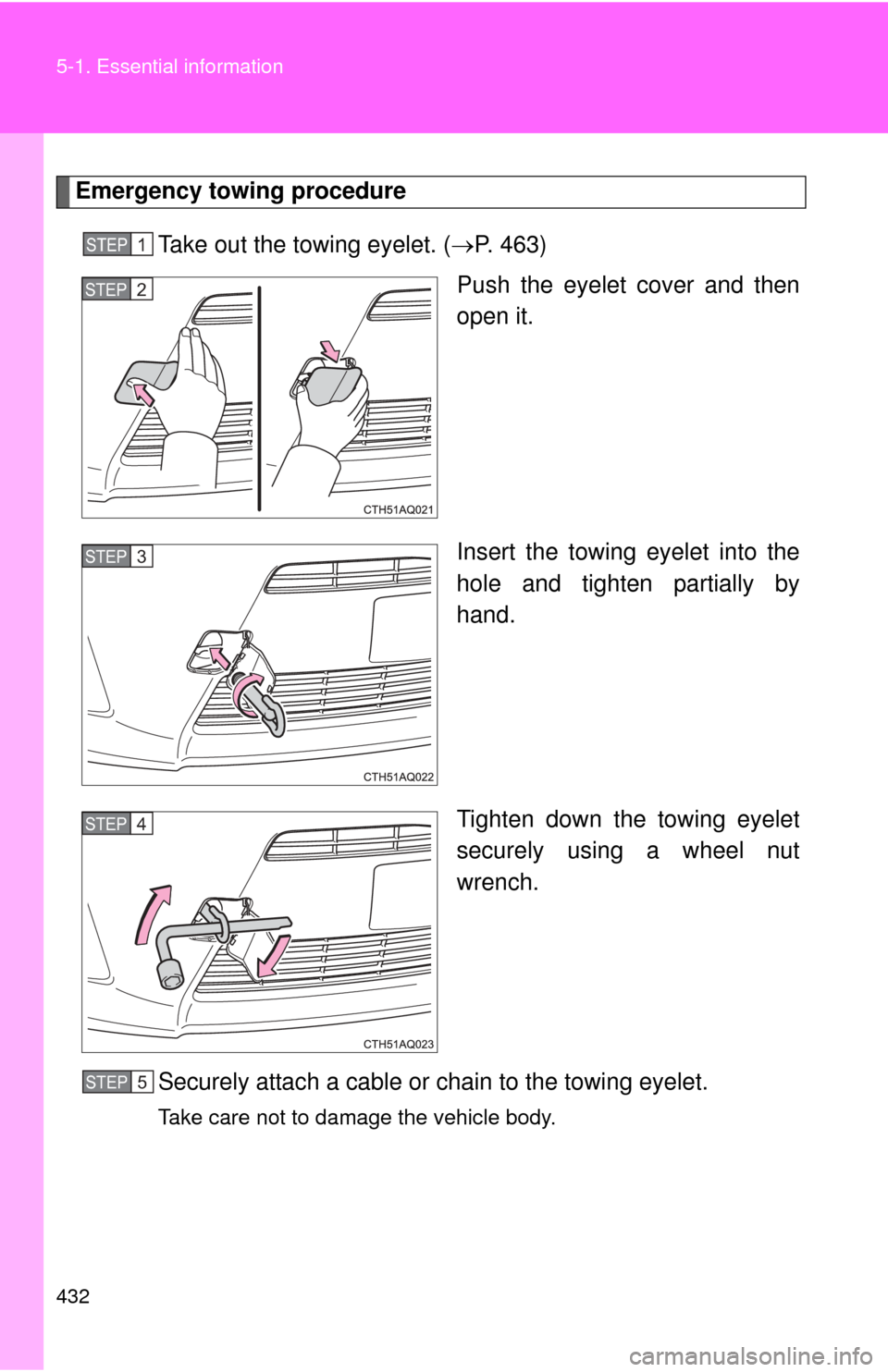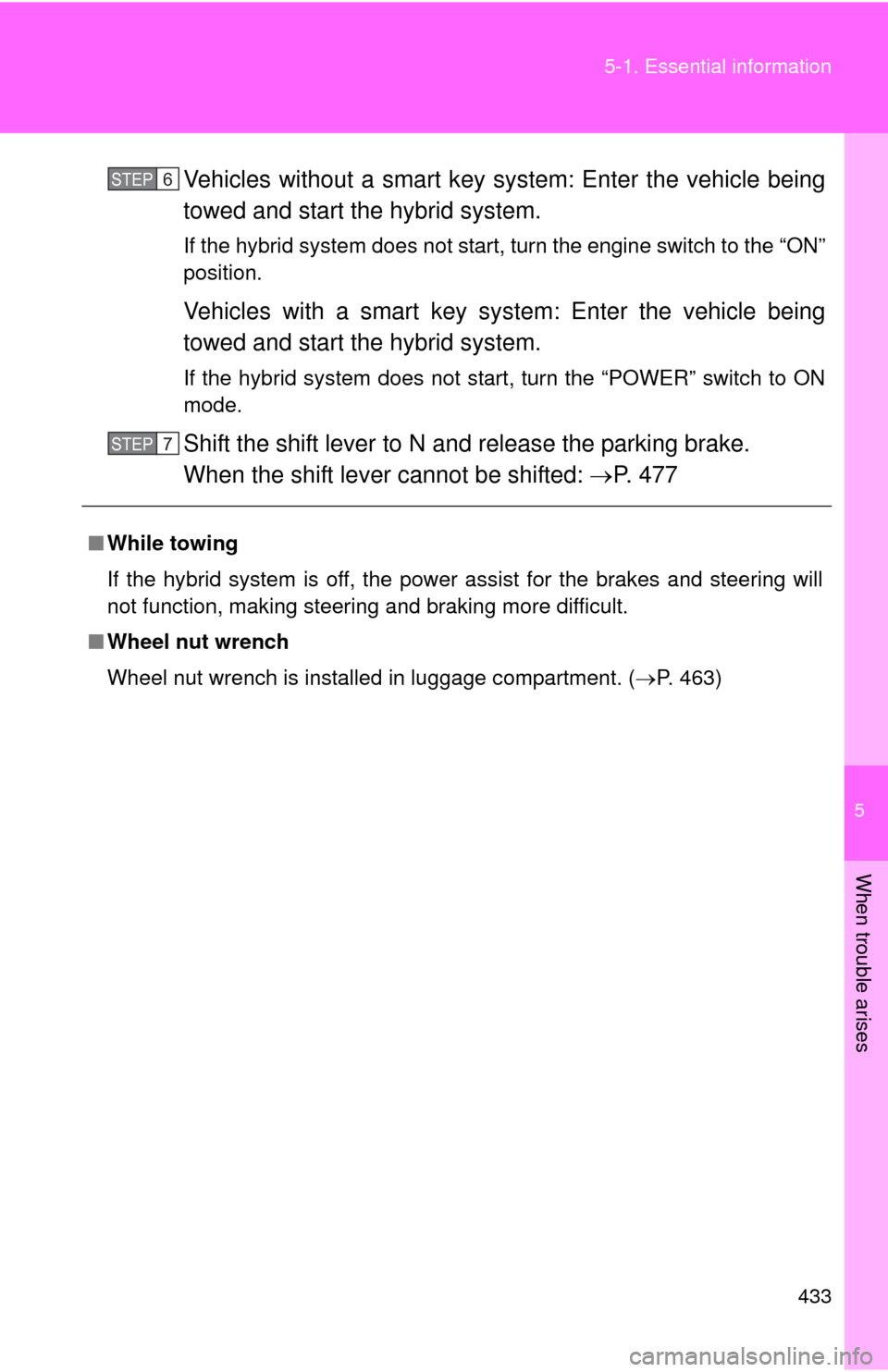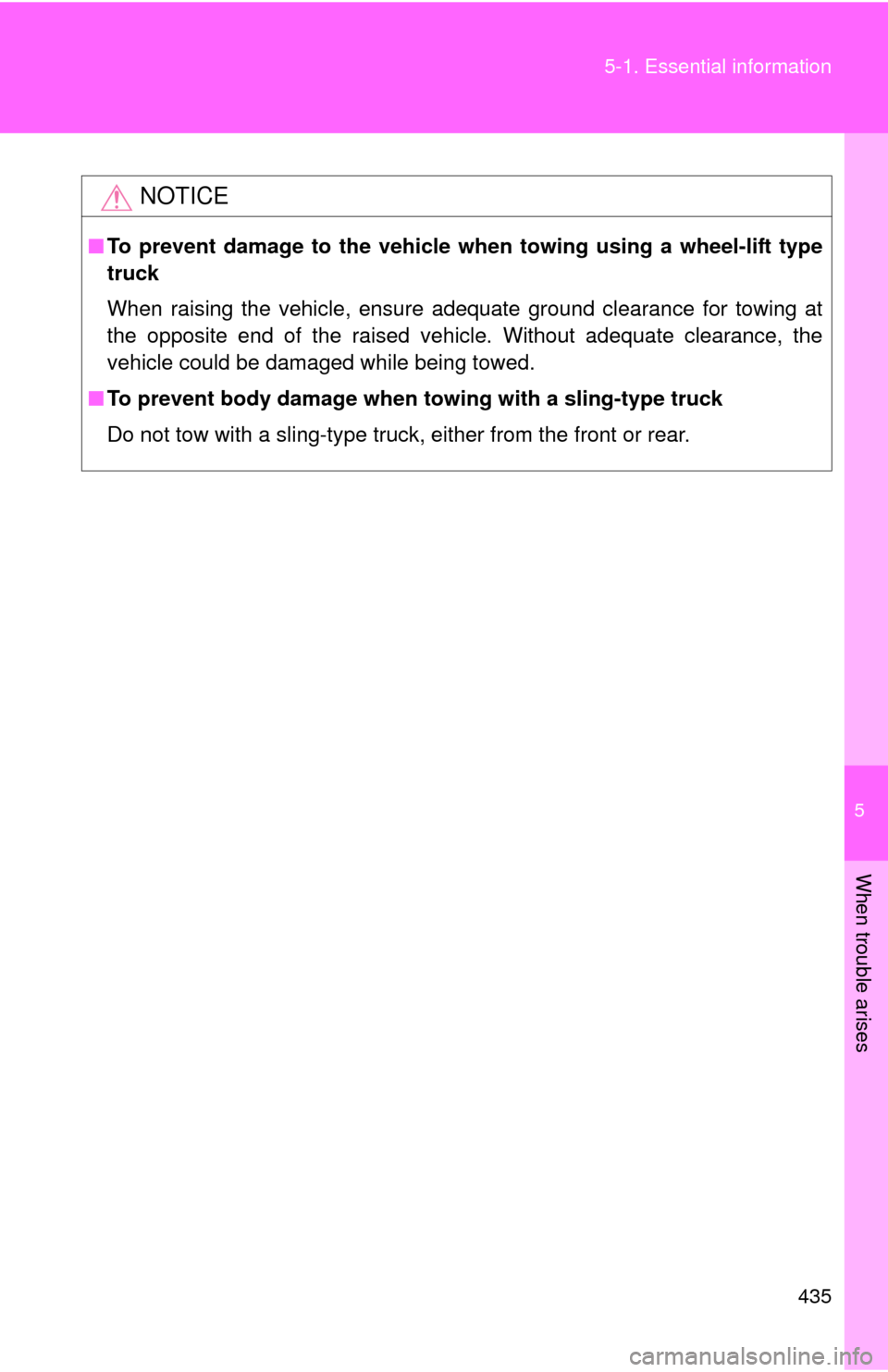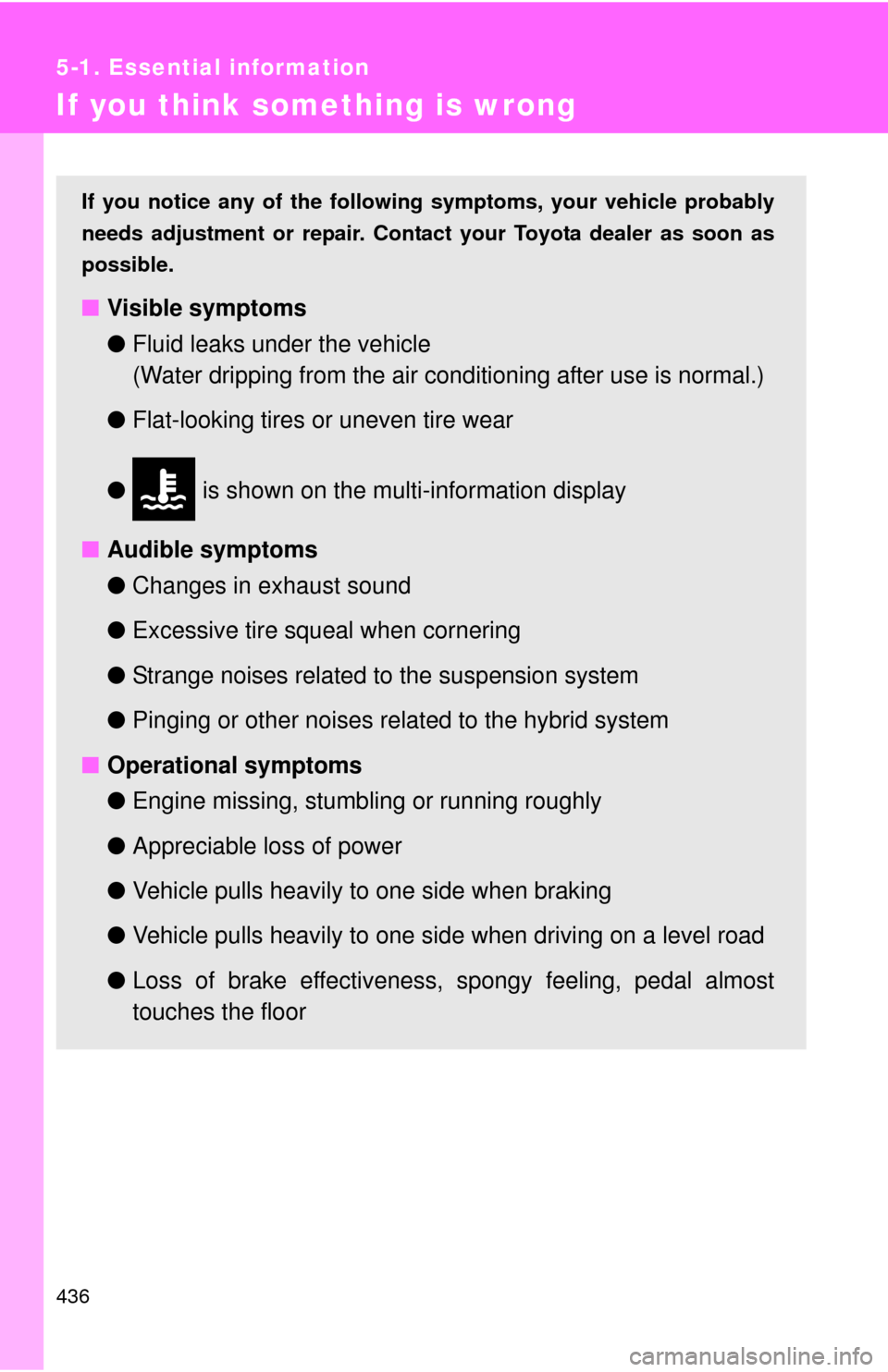TOYOTA PRIUS C 2014 NHP10 / 1.G Owners Manual
PRIUS C 2014 NHP10 / 1.G
TOYOTA
TOYOTA
https://www.carmanualsonline.info/img/14/6627/w960_6627-0.png
TOYOTA PRIUS C 2014 NHP10 / 1.G Owners Manual
Trending: change key battery, coolant temperature, child restraint, Bulb replacement, wiper blades, Check, low beam
Page 431 of 563
428
5-1. Essential information
Emergency flashers
■Emergency flashers
If the emergency flashers are used for a long time while the hybrid system is
not operating (while the “READY” indicator is not illuminated), the 12-volt
battery may discharge.
The emergency flashers are used to warn other drivers when the
vehicle has to be stopped in the road due to a breakdown, etc.
Press the switch.
All the turn signal lights will
flash. To turn them off, press
the switch once again.
Page 432 of 563
5
When trouble arises
429
5-1. Essential information
If your vehicle needs to be towed
Situations needs to contact dealers before towingThe following may indicate a problem with your transmission. Contact
your Toyota dealer before towing.
● A warning message for the hybrid system is shown on the multi-
information display and the vehicle does not move.
● The vehicle makes an abnormal sound.
If towing is necessary, we recommend having your vehicle towed by
your Toyota dealer or a commerci al towing service, using a lift-type
truck or flatbed truck.
Use a safety chain system for all to wing, and abide by all state/pro-
vincial and local laws.
If towing your vehicle with a wheel- lift type truck from the front, the
vehicle's rear wheels and axles must be in good conditions.
( P. 430, 434)
If they are damaged, use a towing dolly or flatbed truck.
Page 433 of 563
430 5-1. Essential information
Towing with a sling-type truckDo not tow with a sling-type truck
to prevent body damage.
Towing with a wheel-lift type truckFrom the front Release the parking brake.
From the rear Use a towing dolly under the
front wheels.
Page 434 of 563
5
When trouble arises
431
5-1. Essential information
Using a flatbed truck
If your Toyota is transported by a
flatbed truck, it should be tied
down at the locations shown in
the illustration.
If you use chains or cables to tie
down your vehicle, the angles
shaded in black must be 45.
Do not overly tighten the tie
downs or the vehicle may be
damaged.
Emergency towing
If a tow truck is not available in an emergency, your vehicle may be
temporarily towed using a cable or chain secured to the emergency
towing eyelet. This should only be attempted on hard surfaced roads
for short distances at under 18 mph (30 km/h).
A driver must be in the vehicle to steer and operate the brakes. The
vehicle’s wheels, drive train, axles, steering and brakes must be in
good condition.
Page 435 of 563
432 5-1. Essential information
Emergency towing procedureTake out the towing eyelet. ( P. 463)
Push the eyelet cover and then
open it.
Insert the towing eyelet into the
hole and tighten partially by
hand.
Tighten down the towing eyelet
securely using a wheel nut
wrench.
Securely attach a cable or chain to the towing eyelet.
Take care not to damage the vehicle body.
STEP1
STEP2
STEP3
STEP4
STEP5
Page 436 of 563
5
When trouble arises
433
5-1. Essential information
Vehicles without a smart key
system: Enter the vehicle being
towed and start the hybrid system.
If the hybrid system does not start, turn the engine switch to the “ON”
position.
Vehicles with a smart key sy stem: Enter the vehicle being
towed and start the hybrid system.
If the hybrid system does not start, turn the “POWER” switch to ON
mode.
Shift the shift lever to N and release the parking brake.
When the shift lever cannot be shifted: P. 477
■While towing
If the hybrid system is off, the power assist for the brakes and steering will
not function, making steering and braking more difficult.
■ Wheel nut wrench
Wheel nut wrench is installed in luggage compartment. ( P. 463)
STEP6
STEP7
Page 437 of 563
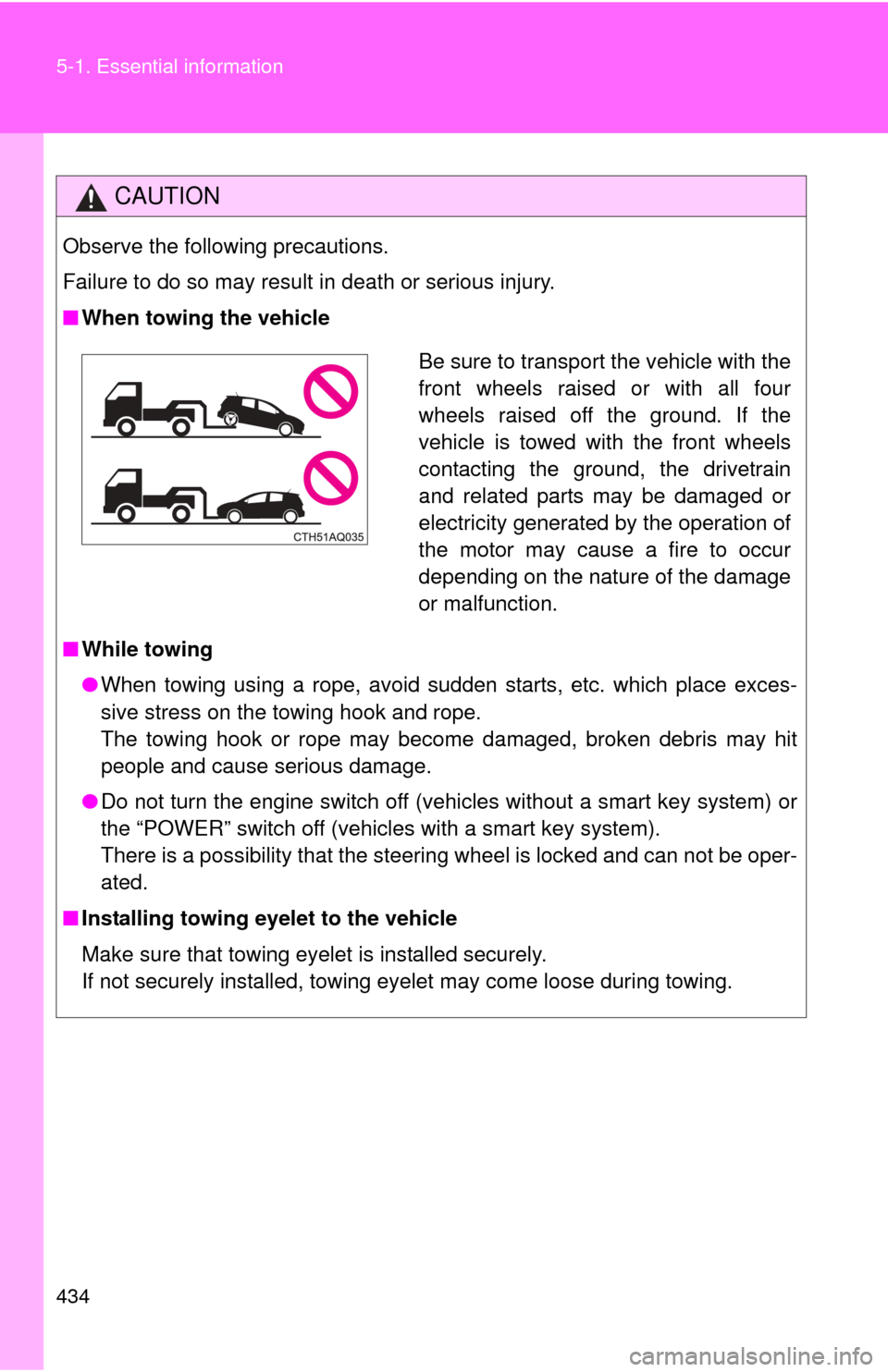
434 5-1. Essential information
CAUTION
Observe the following precautions.
Failure to do so may result in death or serious injury.
■When towing the vehicle
■ While towing
●When towing using a rope, avoid sudden starts, etc. which place exces-
sive stress on the towing hook and rope.
The towing hook or rope may become damaged, broken debris may hit
people and cause serious damage.
● Do not turn the engine switch off (vehicles without a smart key system) or
the “POWER” switch off (vehicles with a smart key system).
There is a possibility that the steering wheel is locked and can not be oper-
ated.
■ Installing towing eyelet to the vehicle
Make sure that towing eyelet is installed securely.
If not securely installed, towing eyelet may come loose during towing.
Be sure to transport the vehicle with the
front wheels raised or with all four
wheels raised off the ground. If the
vehicle is towed with the front wheels
contacting the ground, the drivetrain
and related parts may be damaged or
electricity generated by the operation of
the motor may cause a fire to occur
depending on the nature of the damage
or malfunction.
Page 438 of 563
5
When trouble arises
435
5-1. Essential information
NOTICE
■
To prevent damage to the vehicle when towing using a wheel-lift type
truck
When raising the vehicle, ensure adequate ground clearance for towing at
the opposite end of the raised vehicle. Without adequate clearance, the
vehicle could be damaged while being towed.
■ To prevent body damage when towing with a sling-type truck
Do not tow with a sling-type truck, either from the front or rear.
Page 439 of 563
436
5-1. Essential information
If you think something is wrong
If you notice any of the following symptoms, your vehicle probably
needs adjustment or repair. Contact your Toyota dealer as soon as
possible.
■ Visible symptoms
●Fluid leaks under the vehicle
(Water dripping from the air cond itioning after use is normal.)
● Flat-looking tires or uneven tire wear
● is shown on the multi-information display
■ Audible symptoms
●Changes in exhaust sound
● Excessive tire squeal when cornering
● Strange noises related to the suspension system
● Pinging or other noises related to the hybrid system
■ Operational symptoms
●Engine missing, stumbling or running roughly
● Appreciable loss of power
● Vehicle pulls heavily to one side when braking
● Vehicle pulls heavily to one side when driving on a level road
● Loss of brake effectiveness, s pongy feeling, pedal almost
touches the floor
Page 440 of 563
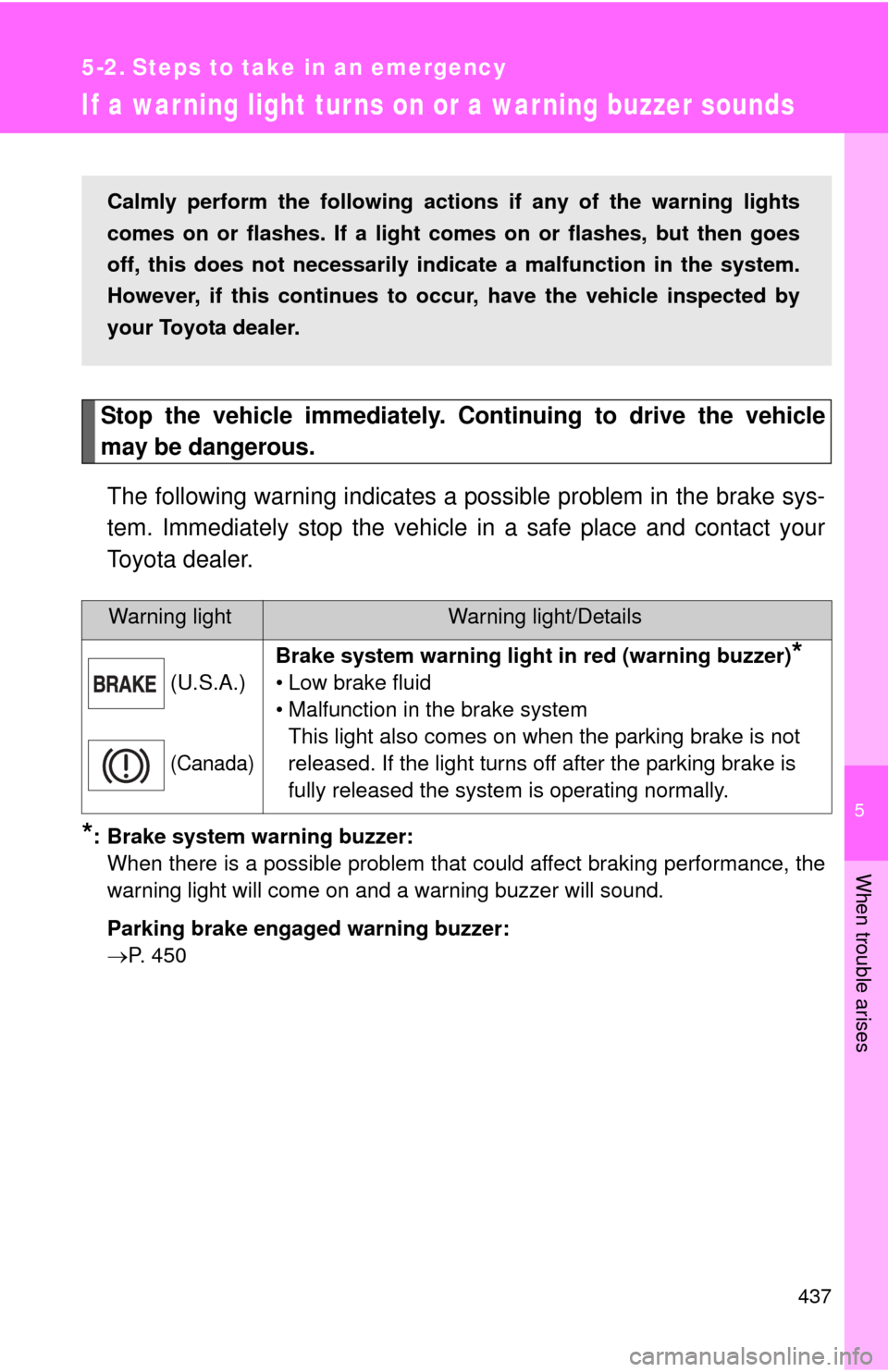
5
When trouble arises
437
5-2. Steps to take in an emergency
If a war ning light turns on or a war ning buzzer sounds
Stop the vehicle immediately. Continuing to drive the vehicle
may be dangerous.The following warning indicates a possible problem in the brake sys-
tem. Immediately stop the vehicle in a safe place and contact your
Toyota dealer.
*: Brake system warning buzzer: When there is a possible problem that could affect braking performance, the
warning light will come on and a warning buzzer will sound.
Parking brake engaged warning buzzer:
P. 450
Warning lightWarning light/Details
(U.S.A.)
(Canada)
Brake system warning light in red (warning buzzer)*
• Low brake fluid
• Malfunction in the brake system This light also comes on when the parking brake is not
released. If the light turns off after the parking brake is
fully released the system is operating normally.
Calmly perform the following actio ns if any of the warning lights
comes on or flashes. If a light comes on or flashes, but then goes
off, this does not necessarily indicate a malfunction in the system.
However, if this continues to o ccur, have the vehicle inspected by
your Toyota dealer.
Trending: check transmission fluid, overheating, TPMS, spare tire, sensor, boot, park assist
